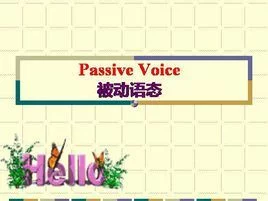英语被动语态

被动语态,即不知道动作执行者或强调动作承受者的一种语态。在英语中,如果想要避免用含混不清的词(如someone)做主语,也可以用被动语态。英语的语态是通过动词形式的变化表现出来的。英语中有两种语态:主动语态和被动语态。主动语态表示主语是动作的执行者。被动语态表示主语是动作的承受者,即行为动作的对象。
- 作品名称 英语被动语态
- 外文名称 the passive voice
- 语态分类 主动语态和被动语态
- 定义 被动语态表示主语是动作的承受者
语法要点
被动:主 + v.[pp.] + by + 人宾
一般现在时:主 + is / are + v.[pp.] (+by +人宾)
一般过去时:主 + was / were + v.[pp.] (+ by +人宾)
现在完成时:主 + have / has + been + v.[pp.] (+ by +人宾)
☆有情态动词的被动:主 + 情 + be + v.[pp.] (+ by +人宾)
情态动词(modal verb):can、should、must
时态 | 主动语态 | 被动语态 |
一般现在时 | ①be ② v. / v.-s | am / are / is + v.[pp.] |
一般将来时 | will / be going to + do | will be + v.[pp.] |
现在进行时 | am / are / is + v.-ing | am / are / is + being + v.[pp.] |
一般过去时 | ①was / were ②v.-ed | was / were + v.[pp.] |
现在完成时 | have / has + v.[pp.] | have / has + been + v.[pp.] |
过去完成时 | had + v.[pp.] | had been + v.[pp.] |
过去进行时 | was / were + v.-ing | was / were + being + v.[pp.] |
情态动词 | 情态动词 + do | 情态动词 + be + v.[pp.] |
句型概述
①(一般将来时):am, is, are, was, were, is going to be , will be+done . 例如: Once environmental damage is done, it takes many years for the system to recover. 本句的意思是:"环境一旦遭到破坏,需要多年时间才能恢复过来。"do作为及物动词有"引起,产生"的含义,do damage的意思是"造成破坏"。主语damage是及物动词do的动作对象,谓语应当用被动语态。
④ 其他时态以此类推,可得到结果。
⑤情态动词的被动语态:主语 + 情态动词 + be动词 + 动词过去分词,例如Your teeth must be brushed.
⑥不定式的被动语态:to be done例:The no-shows have to be considered when deciding the rate of overbooking.(确定超过接待能力的预定时必须考虑预定了房间却来不了的客人。
特殊情况
① 有些动词在主动结构中,后面接不带to的不定式,但如果改为被动,则需把省略的to加上,这类动词有 [let, make, have,help]和感官动词[feel,see,hear,watch,look at,listen to],如:The boss made my grandfather work 10hours a day.改成My grandfather was made to work for 10 hours a day.
② 含有宾语从句的主动结构变为被动,通常用it作为被动结构的先行主语,从句放在句子后面/也可采用另一种形式,这类动词有:know, say, believe, find, think, report等
③ 不是所有的主动句都可以变换成被动句,更不是所有的被动句都可以自由变换成主动句。虽然语法原则上允许主动和被动句的互相转换,但有的句子转换后会变成不通顺或不地道的英语句子。因此,在某些题目里,这也成为判断应该用主动还是用被动的依据。
例:At 5:05 p.m. on Saturday 19th July , there was an accident at the junction of the Main Street and Panda Road when a boy was knocked down off his bicycle by a delivery van. The boy was sent to St. Maria Hospital where he was treated for shock and a broken arm.
在这段文章里,a boy was knocked down off his bicycle by a delivery van这句被动句强调出读到文章的人最关心的事故的受害者。The boy was sent to St. Maria Hospital这句话则说明了孩子被送到医院的事实,至于是由谁(某个过路人?或肇事司机?)送的不重要。he was treated for shock and a broken arm这句被动句无须说出treat这个动作的发出者,因为在医院,伤病员自然由医务人员处理,无须啰嗦。这样,这段文章就重点突出,条理清楚了。
④ 有些动词可以有两个宾语,在用于被动结构时,可以把主动结构中的一个宾语变为主语,另一个宾语仍然保留在谓语后面。多是把间接宾语变为主语。这样句子自然些。直接宾语变为主语时,间接宾语要变为某个介词的宾语,介词to可以省略。如His father left him this house.改为This house was left (to) him by his father.
⑤ 有些动词虽为及物,但宾语并非是动作承受者,不能转换,这些动词有have, hold(容纳),suit, fit, lack, become(适合)contain, cost, last, mean, suffice(足够)等。
⑥ 当直接宾语为反身代词、相互代词或宾语前有指代主语的物主代词时不用被动,如I shook my head.我摇摇头。
⑦ 当宾语为同源宾语(与主句指同一人),动名词,动词不定式或一个从句时不用被动。如John enjoyed seeing the film.
⑧ 在一些固定说法中,有些名词和动词结合的固定说法,不能改We Chinese always keep our word.
⑨ 某些从不及物动词转化来的及物动词,直接宾语在表示动作的方式或效果时,这些动词在意思上起状语的作用,没有被动The girl kissed her boyfriend good night=The girl said good night to her boyfriend by kissing him.(这个女孩说了晚安并且亲了他的男朋友)
⑩ 表地点\处所\组织\长度\大小\数量\程度\抽象名词的词做宾语时不用被动.
⑪ 某些"不及物动词+介词"短语(如walk into, listen to, sleep in, agree with, shake hands with, belong to, take part in, keep up with, happen to, take place等)不能用被动。
⑫ 某些词用主动表被动:sell, miss, build, grow, smell, taste, sound, feel等
时态问题
1.一般现在时的被动语态构成:is / am / are + 及物动词的过去分词
Our classroom is cleaned everyday.
I am asked to study hard.
Knives are used for cutting things.
2.一般过去时的被动语态构成:was / were + 及物动词的过去分词
A new shop was built last year.
Dinosaur eggs were laid long long ago.
3.现在完成时的被动语态构成:has / have + been +及物动词的过去分词
This book has been translated into many languages.
Many man-made satellites have been sent up into space by many countries.
4.一般将来时的被动语态构成:will/shall+ be + 及物动词的过去分词
A new hospital will be built in our city.
Many more trees will be planted next year.
5.含有情态动词的被动语态构成:情态动词+ be + 及物动词的过去分词
Young trees must be watered often.
Your mistakes should be corrected right now.
The door may be locked inside.
Your homework can be handed in tomorrow.
6.现在进行时的被动语态构成:am / is / are + being +及物动词的过去分词
Uncle Wang is mending my bike now.→
My bike is being repaired by Tom now.
They are planting trees over there. →
Trees are being planted over there by them.
7.不定式的被动语态:to + be + 及物动词的过去分词
They are planting twenty more trees. →
There are twenty more trees to be planted by them.
8.过去将来时的被动语态:would /should+ be + 及物动词的过去分词
He said he would finish the work soon.
He said the work would be finished soon by him.
注意事项
1.不及物动词无被动语态。
The dinosaurs disappeared about 65 million years ago.
2.有些动词用主动形式表示被动意义。这些动词主语以物居多,谓语动词一般表示主语的性质和特征。这类动词有许多,如: write, break, sell等。
This pen writes well.
This new book sells well.
3.感官动词或使役动词使用省略to的动词不定式,主动语态中不带to ,但变为被动语态时,须加上to 。 感官动词有smell,sound,taste,fell等。使役动词有let,make,have,help,hear,see,watch,notice,look,listen.
例:make somebody do something→somebody+ be +made to do something
see somebody do something→somebody +be +seen to do something
A girl saw my wallet drop when she passed by.→My wallet was seen to drop by a girl when she passed by.
The boss made the little boy do heavy work.→The little boy was made to do heavy work by the boss.
His mother gave him a present for his birthday.→ He was given a present by his mother for his birthday.
4.如果是接双宾语的动词改为被动语态时,直接宾语(物)作主语,那么动词后要用介词,这个介词是由与其搭配的动词决定。
He gave me a book.→A book was given to me by him.
He showed me a ticket.→A ticket was shown to me by him.
My father bought me a new bike. →A new bike was bought for me by my father.
5.一些动词短语用于被动语态时,动词短语应当看作一个整体,而不能丢掉其中的介词或副词。
We can't laugh at him. →He can't be laughed at by us.
He listens to the radio every day. →The radio is listened to by him every day.
The nurse is taking care of the sick man. →The sick man is being taken care of by the nurse.
6.一些表示状态的动词没有被动语态。如:have, belong to等。
变换规则
把主动语态改为被动语态非常简单,可以遵循以下几个步骤:
1. 先找出谓语动词;
2. 再找出谓语动词后的宾语;
3. 把宾语用作被动语态中的主语;
4. 注意人称、时态和数的变化。
例:1. Bruce writes a letter every week. →A letter is written by Bruce every week.
2. Li Lei mended the broken bike this morning.→The broken bike was mended by Li Lei this morning.
3. He has written two novels so far.→Two novels have been written by him so far.
4. They will plant ten trees tomorrow.→Ten trees will be planted by them tomorrow.
5. Lucy is writing a letter now.→A letter is being written by Lucy now.
6. You must lock the door when you leave.→the door must be locked when you leave.
新兴形式
Get+过去分词也可以构成被动语态,用这种结构的句子侧重于动作的结果而不是动作本身。如: The man got hurt on his way home. 那个男人在回家的路上受伤了。 How did the glass get broken? 杯子怎么破了?
著名学者周海中教授在论文《Get-Passive研究》中指出:Get+过去分词的被动语态是一种新兴的被动语态形式;相对来说它的使用还没有Be+过去分词构成的被动语态那么广泛,一般限于口语和非正式书面语;但它却有着用得愈来愈多的趋势,是一种生气蓬勃的语言现象。